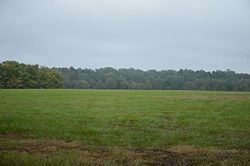Built 1864 Designated NHL April 19, 1994 Added to NRHP 22 March 1974 | NRHP Reference # 74000481 Opened 1864 | |
 | ||
People also search for Elkins' Ferry, Nevada County Depot & Museum, Fort Southerland, Historic Washington State Park | ||
The Prairie d'Ane Battlefield, also known as Prairie D'Ann Battlefield or Prairie De Ann Battlefield, was the Arkansas site of the Civil War Battle of Prairie d'Ane, one of the engagements in the Camden Expedition of 1864. It was listed on the National Register of Historic Places in 1974, and, with other sites, is part of the Camden Expedition Sites National Historic Landmark. It was declared part of the National Historic Landmark in 1994.
Contents
History
The 1864 Camden Expedition was part of a two-pronged strategy by the Union Army to drive Confederate resistance out of southwestern Arkansas and northern Louisiana, and pentetrated into Confederate Texas. Union Major General Frederick Steele led a Union force from Little Rock on March 23, 1864, with the objective of joining forces with Major General Nathaniel Prentice Banks at Shreveport, Louisiana. Confederate forces in Arkansas were directed from Washington, where the Confederate government of the state relocated after the fall of Little Rock. Confederate Major General Sterling Price ordered Brigadier General John S. Marmaduke to harry the Union column and to prevent it from crossing the Little Missouri River as it moved toward Washington. Advance Union forces established a beachhead on the south side of the Little Missouri on April 3, and clashed with Confederate defenders in the Battle of Elkin's Ferry. The outnumbered Confederates were forced to withdraw, and General Price established a defensive position, lightly fortified by earthworks, on the road between Elkin's Ferry and Washington at the western edge of the sparsely-populated Prairie d'Ane, a roughly circular area of prairie surrounded by woodlands. General Steele delayed his advance toward Washington until April 9, awaiting the arrival of addition troops from Fort Smith.
The leading edge of Steele's force began skirmishing with Price's force on April 10, and both sides brought up reinforcements, but the Union advance was halted by fighting that lasted into the night. The next day Union forces advance across the prairie in a battle line in the afternoon, but the lateness of the march meant no general engagement took place, and the Union forces ended up returning to their camps. That night Price withdrew most of his force further down the Washington road, leaving a small guard in the entrenchments on the prairie. The Union again advanced on the 12th, prompting this rearguard to also withdraw, with Union cavalry giving chase for a time. At this point, Steele, whose forces were on half-rations, decided it was necessary to resupply his army. Instead of advancing further toward Washington, he turned toward Camden, a Confederate-held town whose defenses Price had stripped to defend Washington. Price advanced troops in pursuit of the Union army, engaging them in a rearguard skirmish near the hamlet of Moscow (now part of Prescott). Due to difficulties resupplying is force while in Camden, Steele ended up withdrawing all the way back to Little Rock.
Battlefield
The main battle took place over an area estimated to cover some 5,000 acres (2,000 ha) in and around where the city of Prescott (established in 1873) is now located. Much of this area has seen agricultural use, and remains lightly developed, with the only major intrusion being the corridor containing railroad tracks and Interstate 30. The Moscow area, where the rearguard action took place, is relatively unaltered, with some development taking place outside the known bounds of the battle area. The Moscow Methodist Church and Cemetery, a site which existed at the time of the battle (although the current church is a 20th-century structure), is listed on the National Register of Historic Places. A land area of more than 2,600 acres (1,100 ha) was designated part of the Camden Expedition Sites, a National Historic Landmark District, in 1994.
